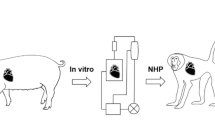Abstract
The current voluntary posthumous organ donation policy fails to provide sufficient organs to meet the demand. In these circumstances xenografts have been regarded as an expedient solution. The public perception seems to be that the only impediments to this technology are technical and biological. There are, however, important ethical issues raised by xenotransplantation that need to be considered as a matter of urgency. When the ethical issues raised by using non-human animals to provide replacement organs for human beings are considered in a wider context and the possible alternatives to xenotransplantation are taken into account, a new dimension is added to the debate. In this broader context it is argued that a less ethically problematic solution is to adopt a presumed consent or opt-out organ procurement policy to regulate posthumous organ harvesting from humans. If there are still too few organs available, then the whole question of transplantation must be reassessed.
Similar content being viewed by others
References
Australian Coordinating Committee of Organ Registries and Donation (ACCORD): 1997, Fact Sheet, Factshee.acc.
ACCORD: 1995, Organ Donation Attitudes Research an\Accinfo\attitude.fsh.
Australians Donate (Australia's National Organ and Tissue Donation and Transplantation Network): 1998, Monthstats 10.xis.
Callahan, J.C.: 1987, ‘On Harming the Dead’, Ethics 97, 341–352.
Caplan, A.L.: 1988, ‘Beg, Borrow, or Steal: The Ethics of Solid Organ Procurement’, In: D. Mathieu (ed.), Organ Substitution Technology. Boulder: Westview Press, pp. 59–68.
Caplan, A.L.: 1989, ‘Ethical Issues Raised by Research Involving Xenografts’, In: T.L. Beauchamp and LeR. Walters (eds.), Contemporary Issues in Bioethics, Third Edition.
Belmont, CA: Wadsworth Publishing Company, pp. 535–541.
Caplan, A.L.: 1991, ‘Beastly Conduct: Ethical Issues in Animal Experimentation’, In: T.A. Mappes and J.S. Zembaty (eds.), Biomedical Ethics, Third Edition. New York: McGraw-Hill, pp. 246–254.
Childress, J.F.: 1989, ‘Ethical Criteria for Procuring and Distributing Organs for Transplantation’, In: J.F. Blumstein and F.A. Sloan (eds.), Organ Transplantation Policy. Durham: Duke University Press, pp. 87–113.
Feinberg, J.: 1984, The Moral Limits of the Criminal Law: Harm to Others. New York: Oxford University Press.
Feinberg, J.: 1985, The Moral Limits of the Criminal Law: Offense to Others. New York: Oxford University Press.
Frey, R.G.: 1980, Interests and Rights: The Case Against Animals. Oxford: Clarendon Press.
Frey, R.G.: 1988, ‘Animal Parts, Human Wholes’, In: J.M. Humber and R.F. Almeder (eds.), Biomedical Ethics Reviews: 1987. Clifton, NJ: Humana Press, pp. 89–107.
Gillon, R.: 1991, Philosophical Medical Ethics. Chichester: John Wiley & Sons.
Kamm, F.M.: 1993, Morality, Mortality Volume I: Death and Whom to Save from It. New York: Oxford University Press.
McCarthy, C.R.: 1996, ‘A New Look at Animal-to-Human Organ Transplantation’, Kennedy Institute Ethics Journal 6(2), 183–188.
Mandel, T.E.: 1993, ‘Future Directions in Transplantation’, Medical Journal of Australia 158(4), 269–273.
Mathieu, D.: 1988, ‘Introduction to Chapter Three’, In: D. Mathieu (ed.), Organ Substitution Technology. Boulder: Westview Press.
Mohacsi, P.J., K.L. Herbertt and J.F. Thompson, J.F.: 1993, ‘Donation and Retrieval of Cadaveric Organs in Australia’, The Medical Journal of Australia 158, 121–124.
Nelson, J.L.: 1992, ‘Transplantation Through a Glass Darkly’, Hastings Center Report 22(5), 6–8.
Pearson, I.Y.: 1993, ‘The Potential Organ Donor’, The Medical Journal of Australia 158(4), 45–47.
Pearson, A., P. Hickson and G. Curry: 1992, ‘Brain Death and Organ Transplantation: The Experiences of Nurses and Families’, UNE Research Report, 1992, pp. 44–47. The authors cite K. Atkins: 1992, ‘The Body and the Person in Organ Procurement and Donation’, The Australian Nurses Journal 22(1), 20-21.
Pitcher, G.: 1984, ‘The Misfortunes of the Dead’, American Philosophical Quarterly 21(2), 183–188.
Partridge, E.: 1981, ‘Posthumous Interests and Posthumous Respect’, Ethics 91, 243–264.
Singer, P.: 1993, Practical Ethics, Second Edition. New York: Cambridge University Press.
Singer, P.: 1994, Rethinking Life and Death. Melbourne: The Text Publishing Company.
Werner, R.: 1988, ‘The Rights and Wrongs of Animal Use for Human Organ Transplant’, In: J.M. Humber and R.F. Almeder (eds.), Biomedical Ethics Reviews: 1987. Clifton, NJ: Humana Press, pp. 65–87.
Wikler, D.: 1988, ‘Ethical and Ideological Assumptions of Organ Substitution Policy’, In: D. Mathieu (ed.), Organ Substitution Technology. Boulder: Westview Press, pp. 22–30.
Author information
Authors and Affiliations
Rights and permissions
About this article
Cite this article
Fisher, J. An expedient and ethical alternative to xenotransplantation. Med Health Care Philos 2, 31–39 (1999). https://doi.org/10.1023/A:1009980400230
Issue Date:
DOI: https://doi.org/10.1023/A:1009980400230




